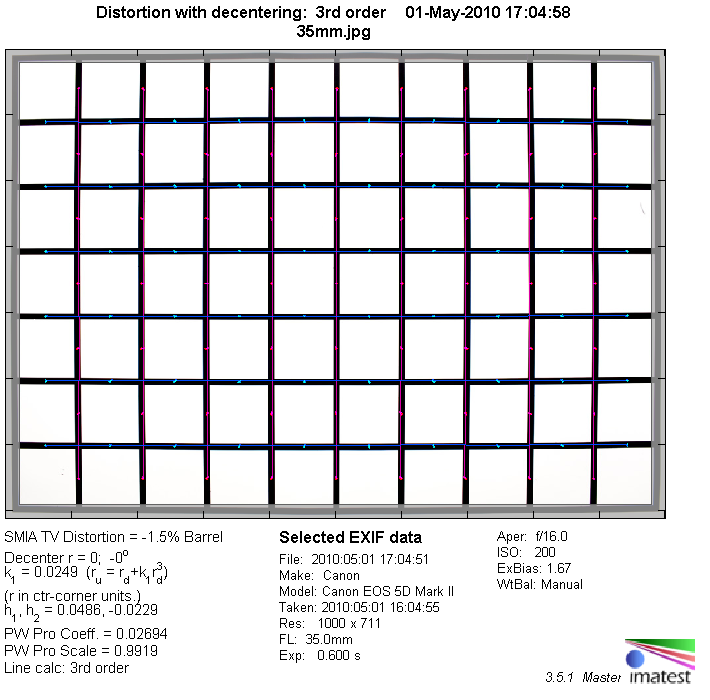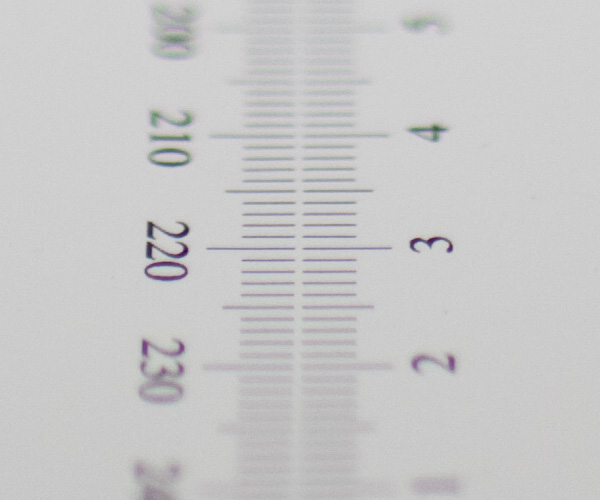|
Canon EF 35mm f/1.4 USM L - Full Format Lab Test Report / Review - Analysis |
|
Lens Reviews -
Canon EOS (Full Format)
|
|
Page 2 of 2

Distortion
The lens generates a slight to moderate amount of barrel distortion (~1.5%) which is quite typical for a moderate wide angle prime lens.

The chart above has a real-world size of about 120x80cm.
Vignetting
Vignetting at large apertures is a weak spot on full format cameras and the EF 35mm f/1.4 USM L has its problems here as well. At f/1.4 it shows a 2.4EV light fall-off in the corners. This isn't quite as extreme as on the EF 24mm f/1.4 USM L II but it's still not impressive. The amount of edge shading is still hefty at f/2 so it's generally a good idea
to stop down to f/2.8 if this is a problem for your application. The aspect is not really field relevant
anymore from f/4 onwards.

MTF (resolution)
The EF 35mm f/1.4 USM L showed a rather mixed resolution characteristic in the MTF lab but this is typical for
ultra-large aperture lenses. The good news is that the center resolution is already excellent at f/1.4. However, the borders and especially the extreme corners are soft here. The global resolution improves slightly at f/2 but if it's an option you should stop down to f/2.8. The center is nothing short of outstanding at this setting. The borders are already very good and the corners have recovered to good levels. The peak performance is reached at f/5.6 with an excellent center and very good to excellent borders/corners. The lens is still easily usable (very good) at f/11 although diffraction starts to take its toll here.
Some keen users may note that the LW/PH figures exceed the resolution of the sensor and as such Nyquist - see this document (bottom) for more details about the procedure if you'd like to dive into this. Imatest can look a bit beyond the sensor resolution by taking some additional parameters into account.
Please note that the MTF results are not directly comparable across the different systems!
Below is a simplified summary of the formal findings. The chart shows line widths per picture height (LW/PH) which can be taken as a measure for sharpness.
If you want to know more about the MTF50 figures you may check out the corresponding Imatest Explanations
Chromatic Aberrations (CAs)
Lateral CAs (visible as color shadows at harsh contrast transitions) can reach an average CA pixel width
of around 1 pixels at the image borders. This is pretty good for such a lens within the full format scope.

Bokeh
The bokeh (the quality of the out-of-focus blur) is a primary aspect for an ultra large aperture lens.
However, the Canon does not totally convince here. It is, of course, capable of producing a very shallow
depth-of-field but especially the foreground blur is a bit nervous at f/1.4 whereas the background blur is generally smoother. Out-of-focus highlights can also be a bit nervous at max. aperture if they reside close to the image borders. The technical quality of the bokeh improves at f/2 and f/2.8 although the blur effect diminishes of course. To be fair - this characteristic is all not overly surprising because wide-angle lenses with aspherical elements are rarely good renowned for the quality of the bokeh. The lens performs better on APS-C DSLRs where the critical border portion is masked out.

Bokeh Fringing / Longitudinal Chromatic Aberrations (LoCA)
Bokeh fringing at large aperture is a problem which is often not well corrected even by the very best
lenses. The Canon produces quite some purple to green out-of-focus halos at f/1.4 as well. The effect
decreases at f/2 but it's still visible at f/2.8.
|
Move the mouse cursor over the f-stop marks below to observe the respective LoCAs
|
| f/1.4 |
f/2 |
f/2.8 |
|

|
Verdict
The Canon EF 35mm f/1.4 USM L is certainly an impressive piece of engineering but it struggles a bit on full format
DSLRs - at least technically. The center resolution is excellent straight from f/1.4 but the borders and extreme
corners are soft here. That said it is certainly capable of delivering images with a very shallow depth-of-field
and that's the primary point of this lens after all. The quality of the bokeh could be a bit better better towards
the borders although we haven't really seen a really good performance from a moderate wide angle lens here so far
anyway. The EF 35mm f/1.4 USM L has naturally some very shiny sides as well. At f/2.8 it produced a new record
in terms of center resolution and at f/5.6 it's pretty much excellent across the image frame so it can be bitingly
sharp for mainstream photography.
The build quality of the EF 35mm f/1.4 USM L is superb but we did only miss some sort of weather sealing like in the
EF 24mm f/1.4 USM L II. The AF is very fast and near silent.
The Canon EF 35mm f/1.4 USM L is not a flawless lens but it can give you great results in the field.
|